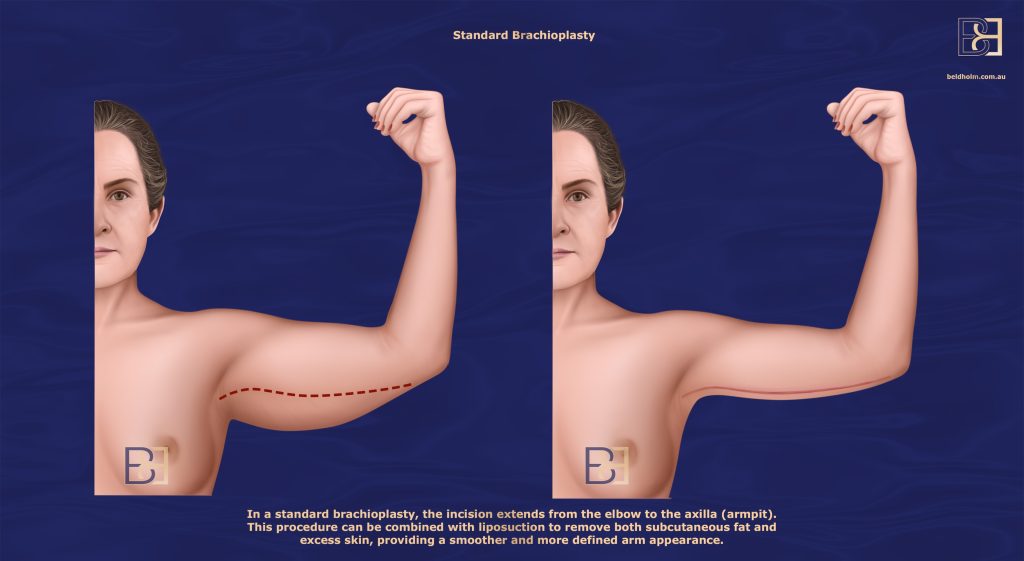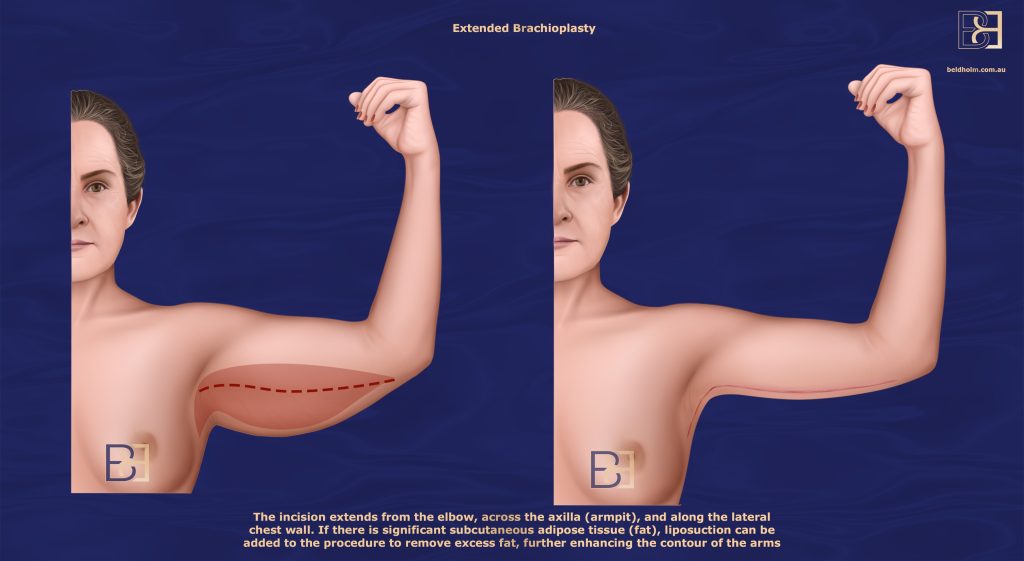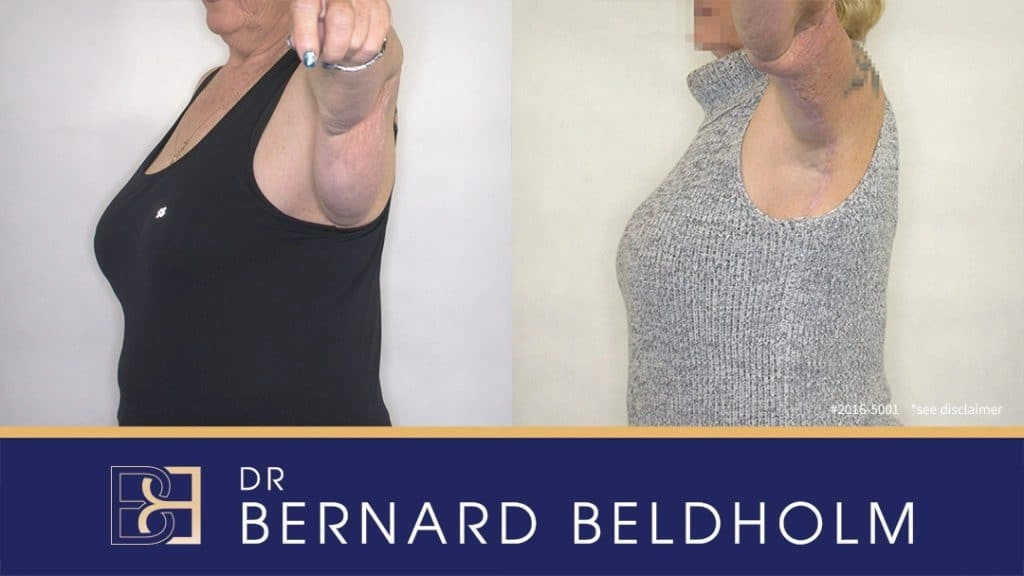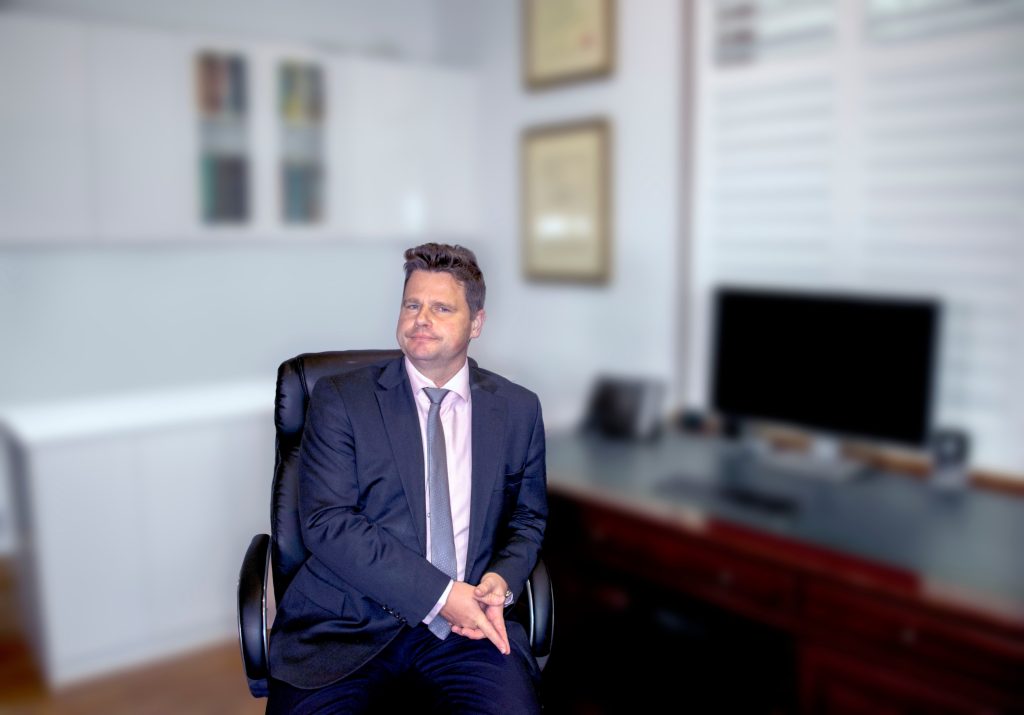Brachioplasty (Arm Lift Surgery) Post Weight Loss in Newcastle, Maitland & Hunter Valley, Australia
Book Online NowBrachioplasty surgery (Arm lift surgery), commonly performed after significant weight loss, is an effective way to remove excess skin and fat from the upper arms. Dr. Bernard Beldholm performs a range of brachioplasty procedures, from mini to standard to extended arm lifts, each tailored to meet the specific needs of the patient. In many cases, liposuction is also included to ** the overall result, by ** both excess skin and adipose tissue.
Key Takeaways
- Dr. Beldholm at Maitland Private Hospital: Dr. Bernard Beldholm performs brachioplasty surgeries at Maitland Private Hospital, offering personalized care. The procedure can be done as a day stay or with an overnight stay for added comfort and recovery.
- Post-Weight Loss Patients: Brachioplasty is commonly performed for post-weight loss patients with significant loose skin in the underarm and chest areas, aiming to ** a firmer arm contour.
- Mini Brachioplasty: The mini brachioplasty is rarely performed, as it does not remove much excess skin and is generally not ideal for patients with significant **.
- Standard and Extended Brachioplasty: The standard brachioplasty focuses on removing excess skin in the underarm area, while the extended brachioplasty includes an incision that extends to the lateral chest wall, ** more extensive skin **.
- Liposuction for ** Results: If there is significant fat in addition to loose skin, liposuction can be added to the procedure for ** contouring and more refined results.
- Combining with Other Post-Weight Loss Surgeries: Brachioplasty can be combined with other post-weight loss skin removal procedures, commonly including breast lifts and abdominal surgeries, to achieve a more comprehensive body contouring result.

Disclaimer: Operation performed by Dr Bernard Beldholm. Adult content, surgery has risks; individual results vary, seek 2nd opinion. Please see the full disclaimer.
Understanding Brachioplasty
Brachioplasty, or arm lift surgery, is a cosmetic surgery designed to reshape the inner upper arm from the armpit to the elbow, effectively removing excess skin and fat. The primary goal of this surgical procedure is to eliminate loose, hanging skin that often results from significant weight loss, aging, or even genetics. This surgery not only tightens the skin but also smoothens and better proportions the contours of the upper arms, resulting in a more balanced appearance.
Book Online NowTypes of Brachioplasty Surgeries
Brachioplasty surgery comes in several variations, each designed to ** different amounts of excess skin and fat. Dr. Beldholm performs these procedures in the Maitland and Newcastle areas, ensuring that each surgery is tailored to the individual patient’s needs. Depending on the amount of loose skin and fat, VASER liposuction may also be included to ** the overall result. The goal of all types of brachioplasty is to remove loose skin and tighten the arm.

Mini Brachioplasty
Mini brachioplasty is a less invasive option ideal for those with minimal excess skin and fat. The procedure involves a smaller incision, usually hidden in the underarm, to remove a limited amount of tissue. This approach is generally not suitable for post-weight loss patients with significant loose skin, as it only ** a small amount of tissue.
However, for patients with minimal loose skin but significant fat, VASER liposuction can be added to the mini brachioplasty. This combination allows for the removal of excess fat while tightening the skin, resulting in tighter arm skin.
Full Brachioplasty (Standard Arm Lift)
Full brachioplasty is designed to ** excess skin in the underarm area. The incision typically runs from the elbow to the axilla (armpit). Post-weight loss patients who have lost a significant amount of weight and are within their ideal BMI range often require only skin removal. However, in many cases, there may still be a significant amount of adipose tissue present in the arms. For these patients, combining brachioplasty with liposuction is ideal. Dr. Beldholm frequently performs VASER liposuction in addition to skin removal during the same operation to create a smaller & tighter arm.


Extended Brachioplasty
Extended brachioplasty ** severe excess skin that affects not only the upper arm but also the side of the chest. This procedure involves additional incisions and may be combined with a lateral chest lift to achieve optimal results. For patients with remaining subcutaneous fat, liposuction can be added to further reduce excess fat on the arm & chest. The lateral chest incision can be combined with the incision made for a breast lift or breast reduction, making these two procedures commonly performed together for patients undergoing extensive body contouring.
Ideal Candidates for Brachioplasty
Ideal brachioplasty candidates are:
- Non-smokers
- Physically **
- Free from medical conditions that could impair healing
- Individuals with a stable weight
- Those with realistic expectations about the surgery’s outcome
Brachioplasty is especially beneficial for those with ** skin due to aging or significant weight loss. After shedding a substantial amount of weight, many find their upper arms left with considerable loose skin and fat, making them prime candidates for brachioplasty.
Ideal candidates for mini brachioplasty are those with minimal skin laxity, stable weight, and seeking modest **. This less invasive approach is ideal for those with slight excess skin, using smaller incisions for minimal scarring.
In contrast, patients seeking extended brachioplasty typically have severe skin ** affecting both the arms and surrounding areas. Each brachioplasty type is tailored to the patient’s specific needs, ensuring optimal results.
The Brachioplasty Procedure
Dr. Beldholm’s approach to brachioplasty is comprehensive and patient-centered. Many post-weight loss patients have multiple areas of concern, and Dr. Beldholm takes the time to understand all these aspects. His initial consultation is a thorough 1-hour session where he reviews your concerns, medical history, and aesthetic goals. This consultation allows patients to openly discuss their expectations and any apprehensions. Based on this discussion, Dr. Beldholm creates a personalized surgical plan that ** all of the patient’s issues. A follow-up consultation is typically provided free of charge, and many patients find that additional follow-ups are helpful to ensure optimal outcomes. For added convenience, Zoom consultations are also available.
Initial Consultation with Dr Beldholm
The initial consultation with Dr. Beldholm involves a comprehensive review of the patient’s health history, aesthetic concerns, and treatment goals. It allows patients to express their ** and any concerns, while Dr. Beldholm provides guidance on potential solutions. This ensures that the surgery is tailored to the patient’s specific needs.
Surgery Day
The brachioplasty procedure is performed at Maitland Private Hospital, with options for day stay or overnight recovery, depending on the complexity of the surgery. TIVA (Total Intravenous Anesthesia) is generally used for the procedure.
- Mini Brachioplasty typically takes about 1 hour.
- Standard Brachioplasty usually requires 3 hours to complete.
- Extended Brachioplasty takes around 4 hours.
If liposuction is added to the procedure to remove excess fat, this will typically add 1-2 additional hours to the surgery time, depending on the amount of fat that needs to be removed. The procedure starts with liposuction to ** any excess fat in the arms, followed by the removal of loose skin to create a firmer, more defined arm contour.
Post-surgery, patients may have drainage tubes to help manage fluid accumulation (Dr Beldholm usually does not use drains for Brachioplasty surgery), and pain management will include prescribed medications and ice packs to reduce swelling and discomfort.
Combining Liposuction
Liposuction is often combined with brachioplasty to ** the overall outcome. It removes excess fat, particularly from the arms, and helps to ** the result by ** both skin and fat. This combination is particularly beneficial for patients with significant subcutaneous fat in addition to loose skin, offering more refined and balanced results.
Incision Techniques and Scar Management

Disclaimer: Operation performed by Dr Bernard Beldholm. Adult content, surgery has risks; individual results vary, seek 2nd opinion. Please see the full disclaimer.
Effective incision techniques and scar management are crucial for the success of brachioplasty. The placement of incisions is strategically chosen to limit scar length and ensure they are in the least conspicuous position. This careful approach helps to minimize visible scars and ** the overall cosmetic outcome. Scars, while permanent, do fade over time and can become less noticeable with proper care. This process can continue for at least 2 years after surgery, during which the healing process gradually ** the appearance of the scars. Patients are encouraged to follow recommended scar management techniques, including the use of silicone gel sheets and regular massage, to promote smoother skin and reduce hypertrophic scars. Additionally, maintaining a ** lifestyle, including a balanced diet and avoiding smoking, can significantly contribute to better healing and more refined scar appearance.
Effective scar management is crucial for improving appearance and overall ** with the surgical outcome. Here are some key points to consider:
- Factors like smoking and poor diet can negatively impact healing and worsen scar visibility.
- Silicone gel sheets can significantly reduce scar appearance after wounds have healed.
- Full scar ** can take around 2 years, although they gradually fade over time.
- Proper care of the surgical site, including cleanliness and dryness, is crucial for minimizing scar visibility.

Recovery Process After Brachioplasty
The recovery process after brachioplasty involves several stages, each crucial for a smooth and successful healing journey. Immediate post-surgery care, long-term recovery, and managing potential complications are integral parts of this process.
Patients generally need to stay overnight in the hospital, manage arm pain with prescribed medication, wear compression garments for 4-6 weeks, and return to non-manual work after two weeks.
Immediate Post-Surgery Care
Immediate post-surgery care is vital for a smooth recovery after brachioplasty. Monitoring for severe pain or abnormal symptoms is crucial immediately after surgery. A drainage tube may be placed post-surgery to prevent fluid accumulation.
Wearing a compression garment can reduce swelling and ** scar appearance. Proper care of the surgical site, including keeping it clean and dry, is crucial for minimizing scar visibility.
Long-Term Recovery
Long-term recovery involves wearing compression garments for about six weeks to support healing. Patients can typically return to work within two weeks after surgery, or even one week for sedentary jobs. It may take up to 2-3 months for all swelling to resolve, marking the end of the healing process.
Once bruising and most swelling subside, patients can gradually resume normal activities and engage in light physical exercises to maintain their arm lift results.
Potential Complications
Like any surgical procedure, brachioplasty carries potential risks and complications. These include:
- Seroma (fluid accumulation)
- Nerve injuries
- Loss of skin sensation
- Visible skin irregularities
- Swelling
- Tightness
- Infections
- Bleeding requiring treatment
Sensory nerve damage can cause prolonged or permanent numbness, another potential complication. The infection rate for arm lift surgery is about 3.64%.
Patients should discuss potential outcomes and specific risks with their specialist surgeon to ensure they are fully informed before undergoing the procedure. Understanding these risks and knowing how to manage them is crucial for a successful recovery and achieving the **.

Disclaimer: Operation performed by Dr Bernard Beldholm. Adult content, surgery has risks; individual results vary, seek 2nd opinion. Please see the full disclaimer.
Results and Benefits of Brachioplasty
For post-weight loss patients, brachioplasty provides significant ** by removing excess skin and fat from the arms, ** both functional and aesthetic concerns. Loose skin in the arms can cause issues like poor-fitting clothes, skin rashes, pain, and limitations in exercise or daily activities.
Some Benefits Include:
- Better clothing fit, as many patients find that clothes fit more comfortably.
- Reduced rashes and rubbing caused by excess skin.
- ** arm appearance
- ** function, making daily activities and exercise easier.
- Easier to exercise, with more freedom of movement and comfort.
Maintaining Your New Look
Maintaining the results of your brachioplasty requires a commitment to a ** lifestyle, including a stable weight and regular exercise. Future weight fluctuations can lead to the return of ** skin, so it’s crucial to keep your weight consistent. A balanced diet and proper hydration play significant roles in supporting the long-term recovery process and maintaining the new body contours. These habits not only aid in skin healing but also help minimize residual swelling, ensuring that the results of your arm lift surgery are long-lasting.
Regular exercise is essential for preserving the results of your brachioplasty, as it helps maintain muscle tone and overall fitness.
Final Conclusion: Brachioplasty with Dr. Beldholm

As a surgeon, I understand the challenges many post-weight loss patients face with excess skin and fat in the arms. Brachioplasty is a ** procedure that can significantly ** both the appearance and function of the arms. By removing loose skin and targeting stubborn fat, we can ** a firmer arm while also ** common issues like discomfort, rashes, and limitations in movement.
I take a personalized approach with each of my patients, ensuring that the procedure is tailored to your specific needs. Whether we’re performing a mini, standard, or extended brachioplasty, I work closely with you to achieve the best possible result. For those who have excess fat along with skin, liposuction can be added to ** the overall contour.
Ultimately, brachioplasty is about **. You’ll find it easier to exercise and wear more comfortable clothes. I’m here to guide you through every step of the process, helping you achieve the body you’ve worked so hard for.
Frequently Asked Questions
Who are the ideal candidates for brachioplasty?
The ideal candidates for brachioplasty are individuals who are non-smokers, physically ** without hindering medical conditions, maintain a stable weight, possess excess soft tissue in the lower arm, and have realistic expectations about the procedure.
How is brachioplasty performed?
Brachioplasty is performed by initially using VASER liposuction to eliminate excess fat from the arms, followed by the excision of loose skin. This comprehensive approach ** the upper arms.
What are some benefits of an arm lift?
An arm lift offers significant benefits such as the removal of loose skin, ** of firmness and symmetry, and reduction of localized fat pockets, leading to better functional arms. Additionally, it can ** comfort during various activities.
What is the typical recovery process after brachioplasty?
The typical recovery process after brachioplasty includes an overnight hospital stay, pain management with medication, wearing compression garments for 4-6 weeks, and a return to non-manual work after two weeks. It is essential to follow post-operative instructions for optimal healing.
What are potential complications from a brachioplasty?
Potential complications from a brachioplasty include seroma, nerve injuries, loss of skin sensation, visible skin irregularities, swelling, tightness, infections, and bleeding that may necessitate further treatment. It is essential to discuss these risks with your surgeon to ensure informed decision-making.
